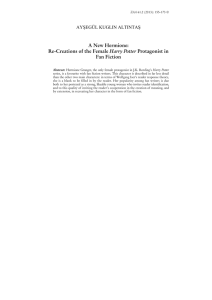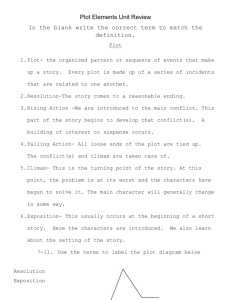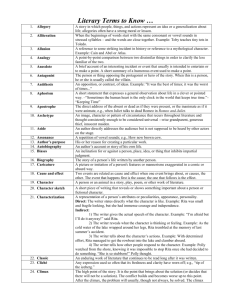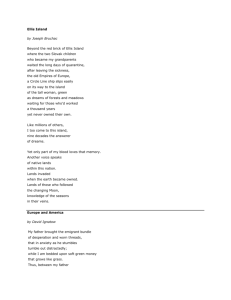Fiction Literature Terms
advertisement
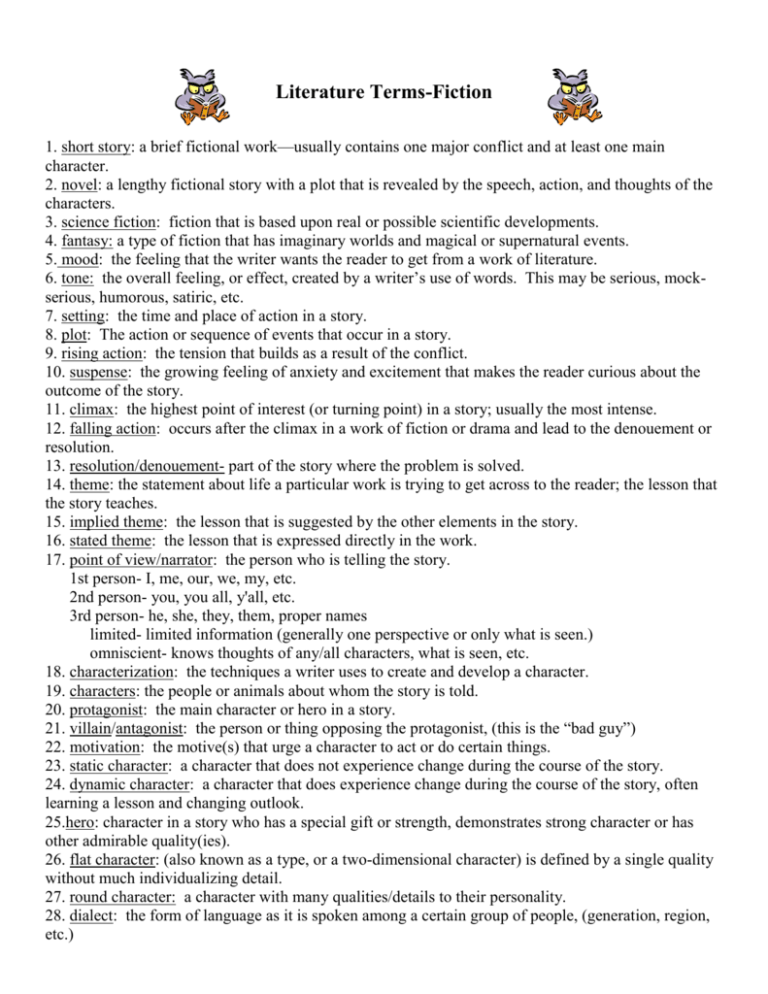
Literature Terms-Fiction 1. short story: a brief fictional work—usually contains one major conflict and at least one main character. 2. novel: a lengthy fictional story with a plot that is revealed by the speech, action, and thoughts of the characters. 3. science fiction: fiction that is based upon real or possible scientific developments. 4. fantasy: a type of fiction that has imaginary worlds and magical or supernatural events. 5. mood: the feeling that the writer wants the reader to get from a work of literature. 6. tone: the overall feeling, or effect, created by a writer’s use of words. This may be serious, mockserious, humorous, satiric, etc. 7. setting: the time and place of action in a story. 8. plot: The action or sequence of events that occur in a story. 9. rising action: the tension that builds as a result of the conflict. 10. suspense: the growing feeling of anxiety and excitement that makes the reader curious about the outcome of the story. 11. climax: the highest point of interest (or turning point) in a story; usually the most intense. 12. falling action: occurs after the climax in a work of fiction or drama and lead to the denouement or resolution. 13. resolution/denouement- part of the story where the problem is solved. 14. theme: the statement about life a particular work is trying to get across to the reader; the lesson that the story teaches. 15. implied theme: the lesson that is suggested by the other elements in the story. 16. stated theme: the lesson that is expressed directly in the work. 17. point of view/narrator: the person who is telling the story. 1st person- I, me, our, we, my, etc. 2nd person- you, you all, y'all, etc. 3rd person- he, she, they, them, proper names limited- limited information (generally one perspective or only what is seen.) omniscient- knows thoughts of any/all characters, what is seen, etc. 18. characterization: the techniques a writer uses to create and develop a character. 19. characters: the people or animals about whom the story is told. 20. protagonist: the main character or hero in a story. 21. villain/antagonist: the person or thing opposing the protagonist, (this is the “bad guy”) 22. motivation: the motive(s) that urge a character to act or do certain things. 23. static character: a character that does not experience change during the course of the story. 24. dynamic character: a character that does experience change during the course of the story, often learning a lesson and changing outlook. 25.hero: character in a story who has a special gift or strength, demonstrates strong character or has other admirable quality(ies). 26. flat character: (also known as a type, or a two-dimensional character) is defined by a single quality without much individualizing detail. 27. round character: a character with many qualities/details to their personality. 28. dialect: the form of language as it is spoken among a certain group of people, (generation, region, etc.) 29. connotation: implied meaning of a word. (opposite of denotation.) 30. denotation: literal meaning of a word, the dictionary meaning. (opposite of connotation.) 31. conflict: the struggle between opposing forces. internal conflict- conflict that occurs within the character's mind external conflict- conflict that occurs outside of the main character 1. man vs. man 2. man vs. nature 3. man vs. society 32. foreshadowing: giving hints or clues of what is to come later in a story. 33. flashback: returning to an earlier time for the purpose of making something in the present more clear. 34. irony: the contrast between what is expected and what actually exists or happens. dramatic: the reader knows information that characters in the story do not. situational: when the opposite occurs in a story than is expected (ex. surprise twist) 35. figurative language: non-literal use of words and/or phrases (figures of speech) 1. simile: a figure of speech comparing two unlike things that uses the words like or as. (ex. You look like a million bucks. 2. metaphor: a figure of speech comparing two unlike things (yet share a common characteristic); does not use like or as. (ex. You are a bull in a china shop. 3. personification: a figure of speech in which inhuman objects are given human characteristics. (ex. The flowers waved to me from the field. 4. hyperbole: a figure of speech in which an exaggeration is made for emphasis or humorous effect. (ex. She was so tall that she could hang the moon. 5. idiom: a nonliteral meaning of a word of phrase (ex. To “kick the bucket” means to die, not to kick a bucket.) 6. pun: figure of speech that is a play on words (humorous) (ex. I wondered why the baseball was getting bigger. Then it hit me. 36. symbol: using an object or action that means something more than its literal meaning. 37. slogan: catch phrase used to advertise something. 38. allusion: a brief reference to a person, event, or place, real or fictitious, or to a work of art. 39. allegory: an symbolic narrative (similar to fable or parable)





